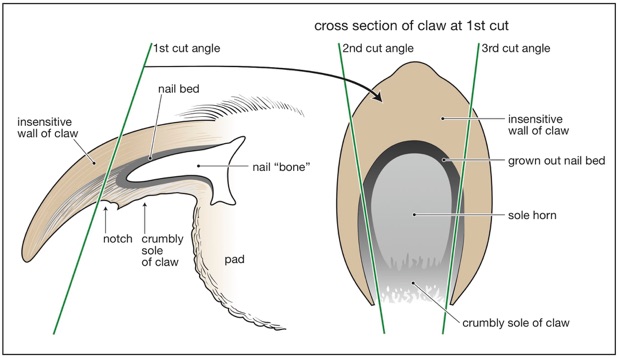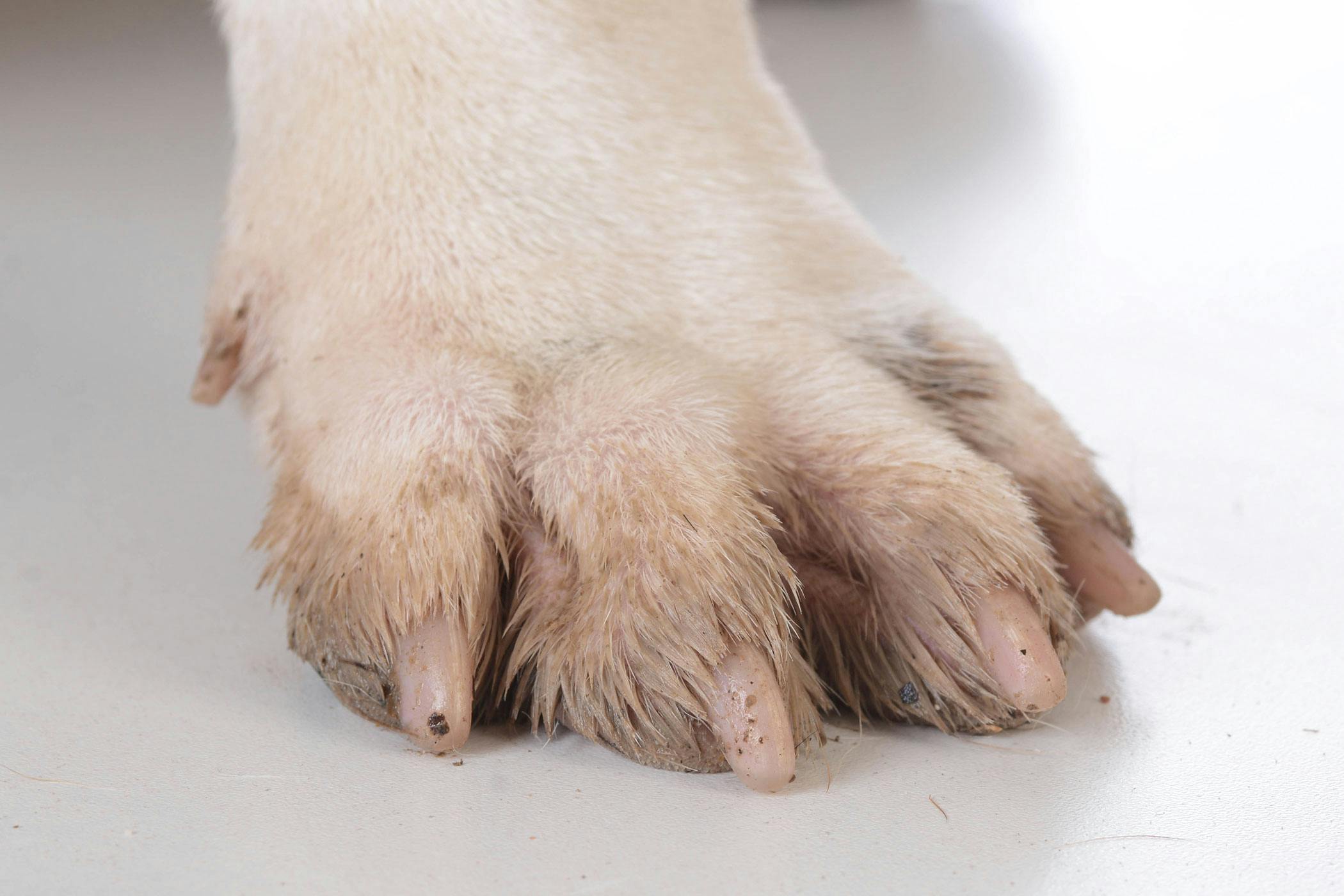
All dogs have an extra claw on each front leg. Many dogs naturally wear their nails down by walking and play especially if the walk involves hard surfaces.

Infections are common in paws because paws are in constant contact with everyday surfaces and germs.
Dog claws or nails. Diseased claws and nails can predispose your pet to trauma lameness and pain. If you see that your dogs nails are not looking as they normally do a visit to the veterinarian is in order. Whiter than normal claws.
Nails that are wider or narrower than normal. Splitting of the nail. Claws have blood vessels inside them if you have seen a dog with a white claw that pink bit in the middle.
Thats the quick which is blood and tissue and nerves and are attached to bones. Nails sit above the bone and do not have any blood inside them below but not inside. Claws are rounded not flat and are for heavy duty for use.
Unlike cats dogs do not have retractile claws. The color of the nail is determined by the color of the surrounding skin and hair. This dog has black claws on the brown paw and a mixture of white and black claws on the white paw.
Always remember to trim the dew claws that are located on the inner surface of the paw. Take a look at your dogs feet. How many toenails do you see.
Most dogs have four nails on each rear foot and five on their front feet. That extra nail on the upper inner part of a dogs foot is the dewclaw. Did you come up with a different total.
Have no fear some dogs have dewclaws on their rear feet or even double dewclaws. Claw conditions that can affect your dog may have additional symptoms of painful walking swelling around the claws and brittle or abnormal nails. Chronic nail biting can create bleeding and secondary infections and should be discussed with your veterinarian.
Reasons why your dog may be chewing his nails include. Dogs should not bite at their nails to trim or shorten them. If your dog is biting at a single nail or multiple nails he or she is most likely itchy around the nails.
Trauma to nails may happen in various formshuman error during nail clipping too close to the nail bed can lead to problems. Be gentle and careful while trimming dog nails. One type of nail disorders paronychia is an infection that causes inflammation around the nail or claw.
Fungal infections such as onychomycosis can also occur in or around the nail bed. Dogs may suffer from extremely brittle nails onychorrhexis or have nails that slough peel or chip away excessively oychomadesis. Clipping your dogs nails is more than a cosmetic chore.
Veterinarians warn that unhealthy nails can cause pain and in rare instances trigger irreversible damage to. Nail and nail bed infections are defined as any abnormality or disease that affects a dogs claw or the areas around it. Infections are common in paws because paws are in constant contact with everyday surfaces and germs.
Canine nails are situated above the paw pads. Pick up a paw and firmly but gently place your thumb on the pad of a toe and your forefinger on the top of the toe on the skin above the nail. Make sure none of your dogs fur is.
Dog claw trimming tips and tricks. Remember to trim your dogs dew claw nail which is located on the inside of the leg. If left untrimmed these nails grow into the soft tissue a bit like an ingrown toenail for us.
If youre still a little daunted dont worry. The more often you trim them the easier it becomes. If this term is unfamiliar dew claws are accessory nails.
All dogs have an extra claw on each front leg. In some pups it projects from the inner ankle. In others it protrudes above the front paw.
Some dog breeds also have hind dew claws including double nails. A healthy dew claw has a smooth surface and uniform colour. Dog nails that become overgrown should be trimmed every two weeks to allow the fleshy quick to recede.
The perfect length for your dogs nails is right around the pads of the paws. You shouldnt be able to hear your dogs claws on a hard floor even though we sometimes use that sound as a way to keep track of mischievous pets. Just like your nails your dogs claws are constantly growing.
Your dogs wild ancestors will have naturally worn down their claws whilst running hunting and scratching but because our pets spend much of their time indoors or running on soft surfaces such as lawns they get very little wear on the claws. Most dog breeds make use of their teeth to hunt instead of their claws because the claw anatomy of dogs is not conducive to hunting. Defense Typically when they need to defend themselves cats use their retractable claws whereas in the case of dogs they mainly use their teeth for defense because their claw anatomy does not allow them to use their claws for defense.
Just like human nails dog claws grow constantly. How often a dogs nails need to be cut will depend on the breed and lifestyle which can change with age. Many dogs naturally wear their nails down by walking and play especially if the walk involves hard surfaces.
An inactive dog may not wear their nails down. Check all your dogs nails including the dew claws which are located further up their leg on the inside they can be on both the front and the hind legs. Theyre not always obvious so they can easily be missed and may start to curl around back into the pad which can be very painful and an infection risk.
Do you know why it is so important to trim your dogs nails. You might notice they are getting a little longer but not think anything about it. Dog claws are a lot thicker and stronger than human nails so youll need specialist nail clippers.
There are bypass clippers and guillotine clippers both are suitable but vets tend to prefer the bypass type. One of them is the dog nail bed infections. Usually claw infections caused by bacteria are responsible for making a dog nail black.
However a fungal infection could also be the cause behind nail discoloration. In the case of mild bacterial infections topical antibiotics are used to treat the disease. However your dog may require a course of.